
Russia blatantly violated all international laws when it invaded its border state Ukraine on February 24. As a result, the European community introduced economic scansions that ended Russia's participation in many joint programs, including space ones. Numerous projects between the Russian space agency Roscosmos and European Space Agency (ESA) have been canceled.
However, there is no need to sound the alarm because ESA can find substitutes for Russian rockets and technologies. The Ukrainian space sector, particularly the private ones led by entrepreneurs like Max Polyakov, offers plenty of opportunities and technical solutions that can replace and even surpass Russian tech.
ExoMars Mission: Original Plans & Future Opportunities
ESA ended its ExoMars mission cooperation with Roscosmos on July 13, 2022. But, even though the Russian Proton rocket will no longer carry the European-built rover to Mars, this mission is still ongoing. Replacements for the Russian launcher, navigation tech, and landing equipment are already underway.
According to Josef Aschbacher, ESA Director General, ending cooperation with Russia on this particular mission was a tough decision, but it had to be taken to ensure the ESA stays true to its principles of respecting international laws and national borders.
Besides, Proton is not the only Russian rocket that will not be launching anything for the ESA any time soon. The Soyuz launcher series used to carry lots of payloads for European customers. In particular, Soyuz ST-B was supposed to deploy two French satellites for ESA's navigation system Galileo, but this launch was canceled, too.
The potential replacements ESA is considering now are Ariane 6 and Vega-C rockets. The first launcher is already in testing, and soon enough, the agency should decide whether it will be used for carrying ESA payloads.
The second option, Vega-C, can become an even greater alternative to Proton and Soyuz. The biggest advantage of Vega-C is that all European countries, including Ukraine, are manufacturing its components, which ensures a fully independent production and maintenance cycle. Plus, Ukraine has a developed scientific and manufacturing base to assist Europe in building new launchers. More importantly, the country has entrepreneurs with experience developing international-scale space projects, like Max Polyakov.
Several companies built by Maxym Polyakov already offer a wide range of quality space-related services to international clients. For example, EOS Data Analytics, founded by the Ukrainian-born entrepreneur in 2015, provides customers with high-resolution SAR and optical imagery from space. EOS Data Analytics is already planning to deploy a constellation of satellites in LEO to further enhance its services for agriculture, mining, construction, and other industry segments. Another company, founded and developed by Max Polyakov, US-based Firefly Aerospace, is building a launcher and has already been picked by NASA to develop lunar lander technology for the upcoming Artemis mission. All of this has been made possible by the entrepreneur's close collaboration with Ukrainian aerospace engineers.
The Future of ESA Lunar Missions
ESA, too, is getting ready for Moon exploration missions of its own. The agency is planning a total of four missions: Lunar Resurs, ISRU, Orion spacecraft, and Heracles.
ESA was supposed to collaborate with Roscosmos on Lunar Resurs - a science initiative for studying soil under the Moon's surface. Roscosmos's part was to provide a lunar lander technology. To this end, the Russian space agency was planning to upgrade its old Soviet tech, Luna. To revitalize the lining equipment developed in the 1970s, Roscosmos planned to equip its upcoming Luna-25 with a new navigation system (PILOT), a lunar drill (Prospect), and a chemistry lab (ProSPA).
Ironically, the original Luna technology was developed by Ukrainian engineers, led by a Ukrainian-born Sergei Korolev. In the past fifty years, Russian engineers did not come up with any new space tech, limiting themselves to adding minor updates to 50-year-old Ukrainian developments. For Ukraine, however, the time did not stand still, and today, the Ukrainian space industry can actually offer new engineering solutions.
Tech Space Technology & Initiatives in Ukraine
Today, the Ukrainian space industry is actively engaged in the development of modern spacecraft under the updated Space Program from the State Space Agency of Ukraine (SSAU).
The Ukrainian private space industry is moving forward in the same direction. New spacecraft calls for innovative component parts, and one Ukrainian startup is already developing ion engines for satellites and orbiters. These engines are as powerful as conventional models, but their low maintenance power results in smaller size and weight, thus saving satellite owners impressive amounts of money.
More Reasons for ESA Ukraine Cooperation
Innovative projects are not the only reason for ESA Ukraine cooperation. The main benefit of working with Ukraine is its talent pool. The country boasts a strong technical base, solid scientific community, and exceptionally skilled workforce. Besides, engaging experienced space entrepreneurs like Max Polyakov will give ESA further opportunities to develop cost-effective programs under the New Space Concept.
Finally, the cat is already out of the bag - since ESA said its farewells to Russian providers, the search for new partners is now a necessity.
Fortunately, the first steps in ESA Ukraine cooperation have already been taken. In fact, this cooperation has been growing steadily since 2014, involving both private and government sectors. For Ukraine, ESA is not the only space partner, though. The country became the ninth to sign the Artemis Accords and is already developing tech for NASA's next moon mission. Still, as a state physically located in Europe, Ukraine is also a perfect match for more ESA space programs and initiatives. Even now, it can give ESA access to thousands of its talented engineers and scientists.
ⓒ 2026 TECHTIMES.com All rights reserved. Do not reproduce without permission.




